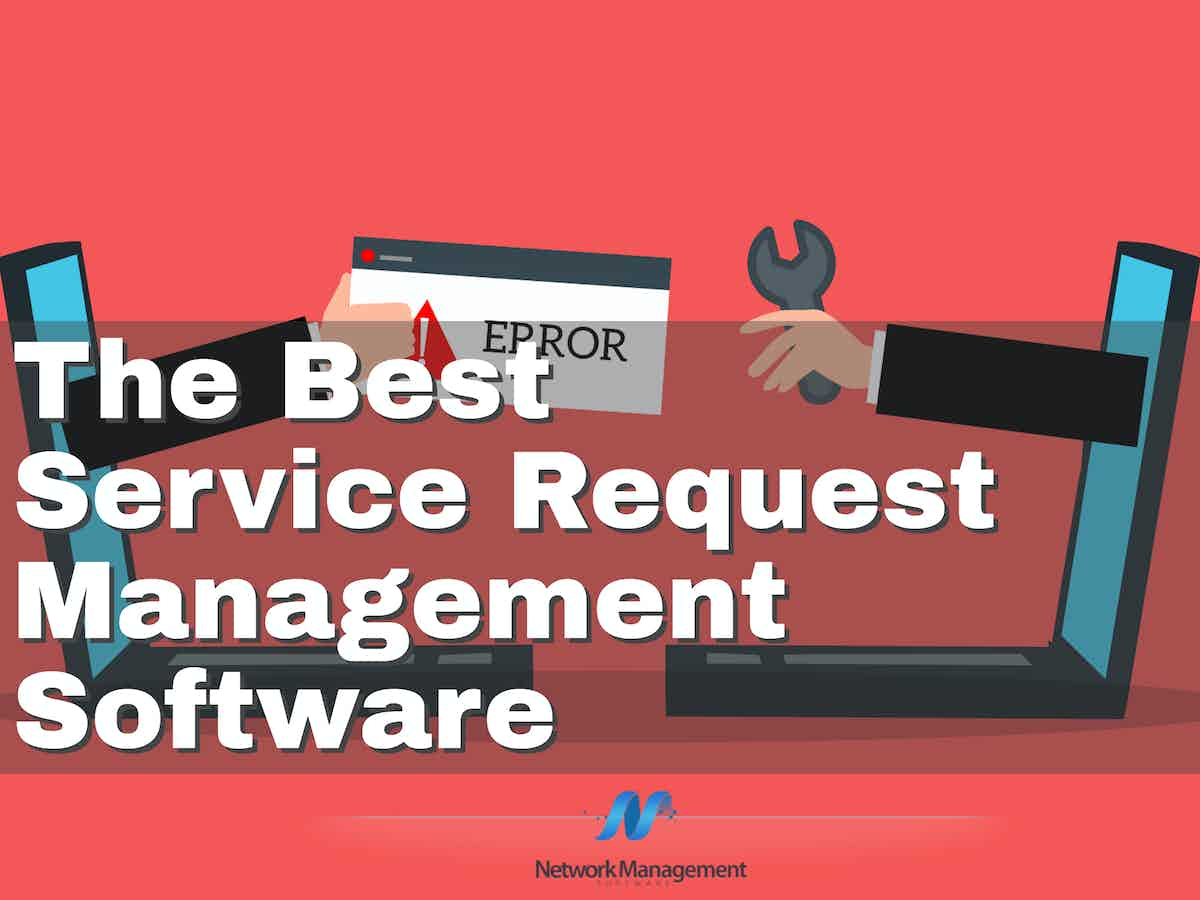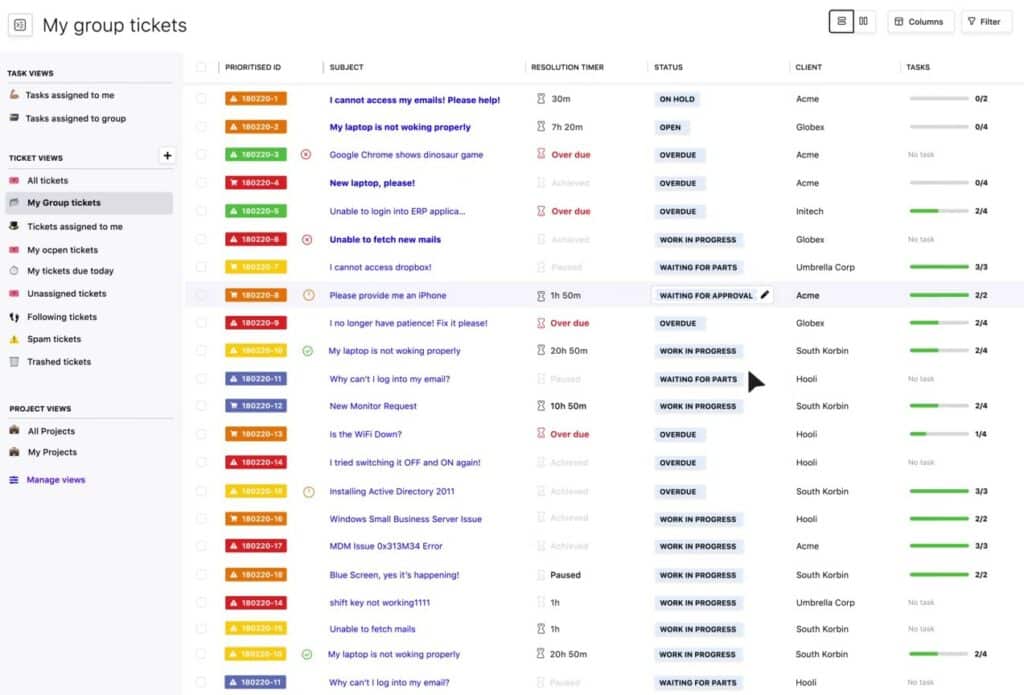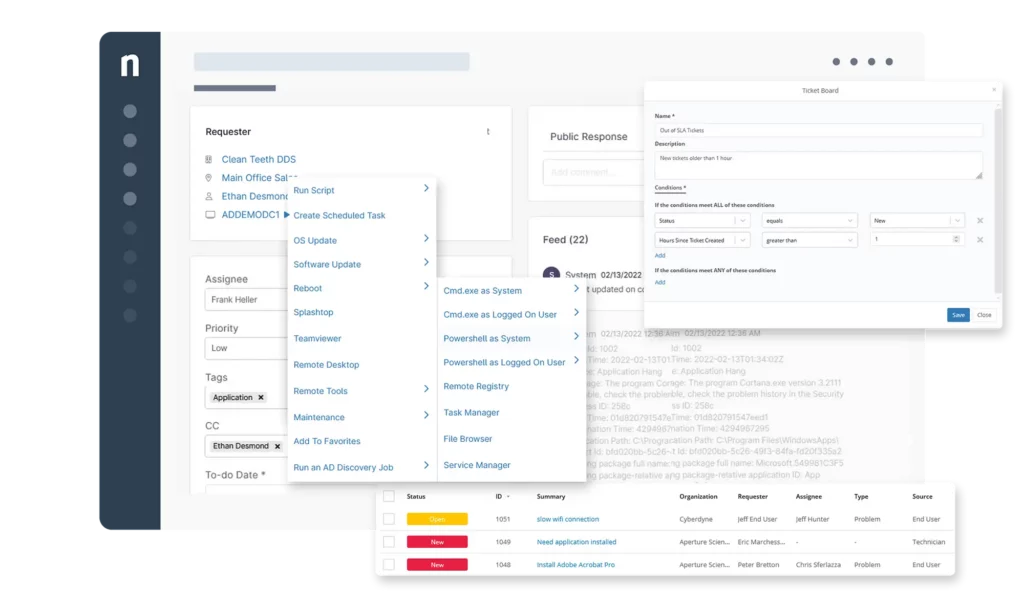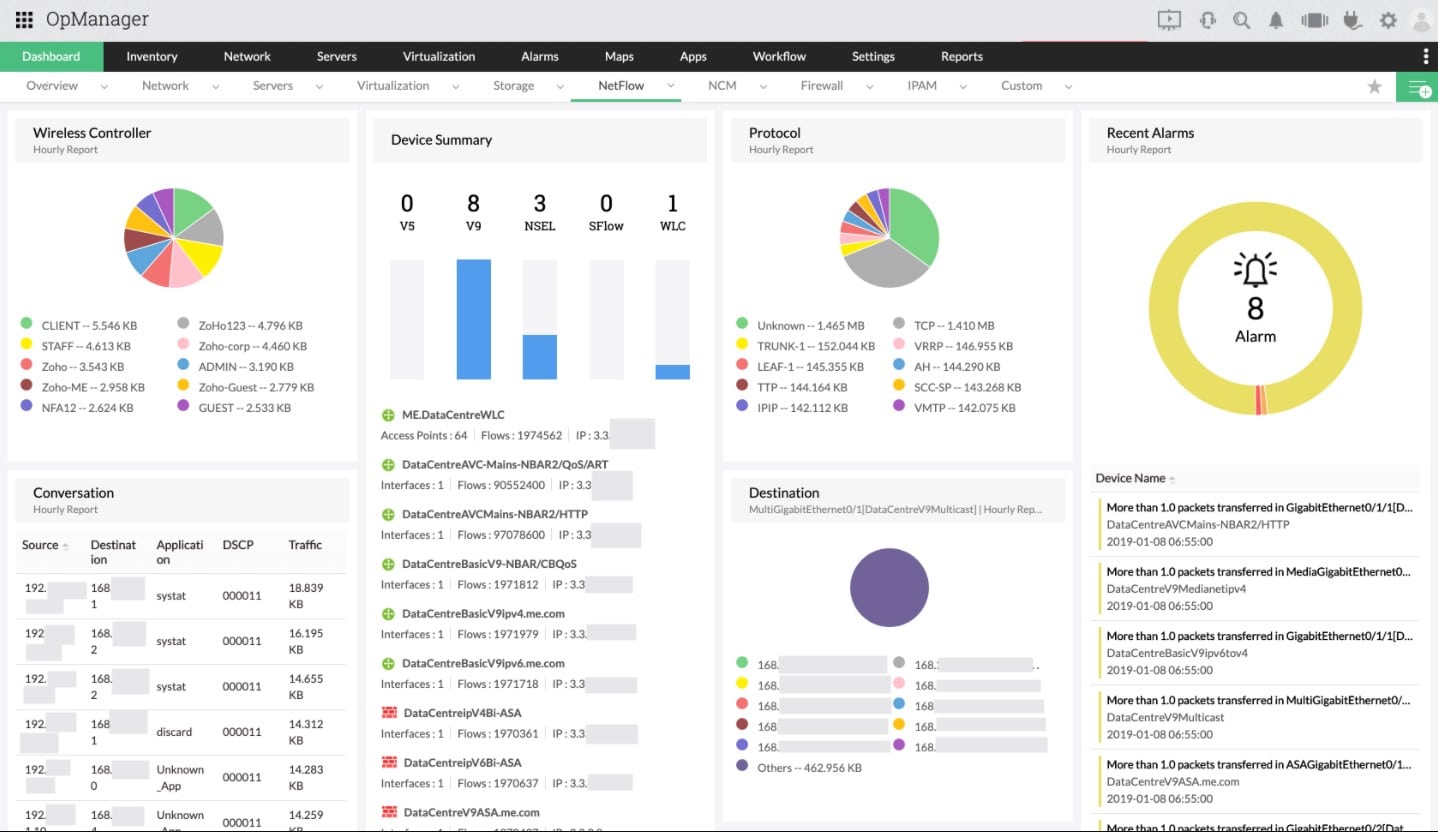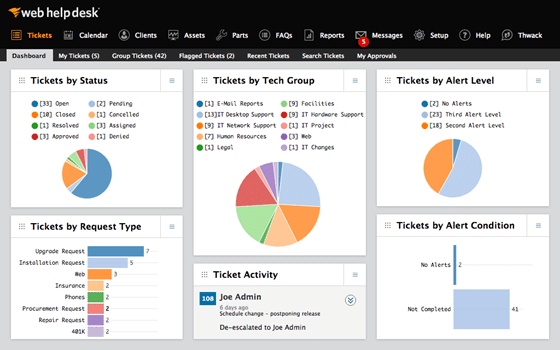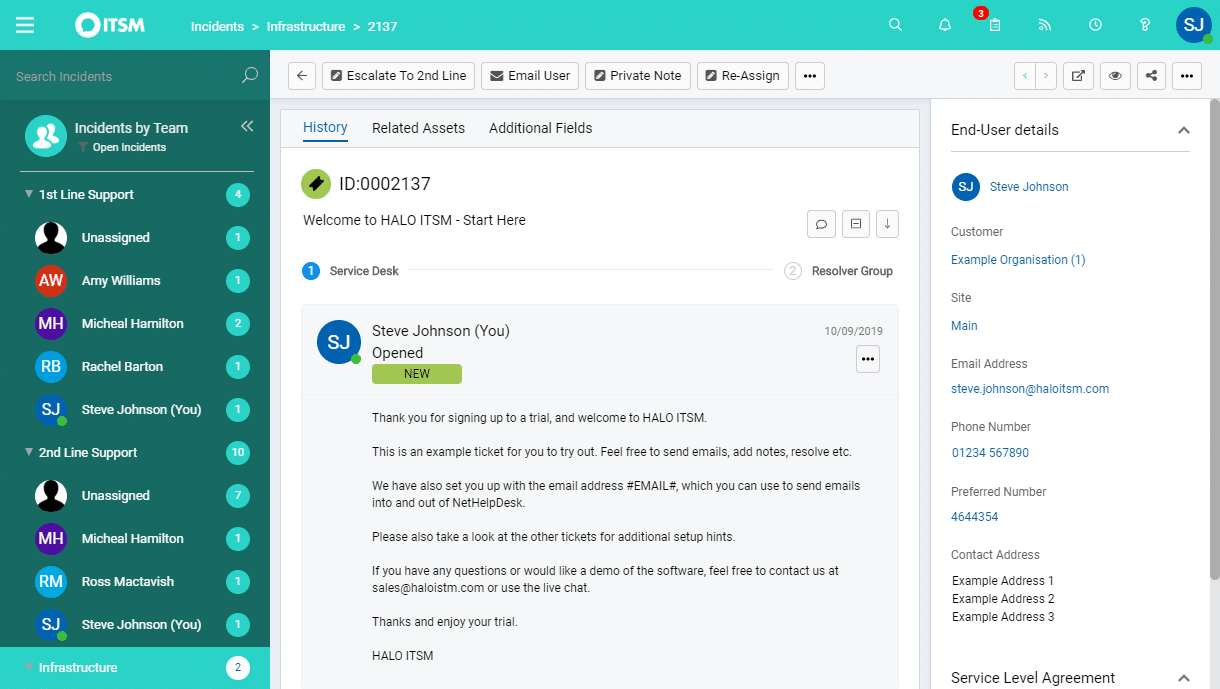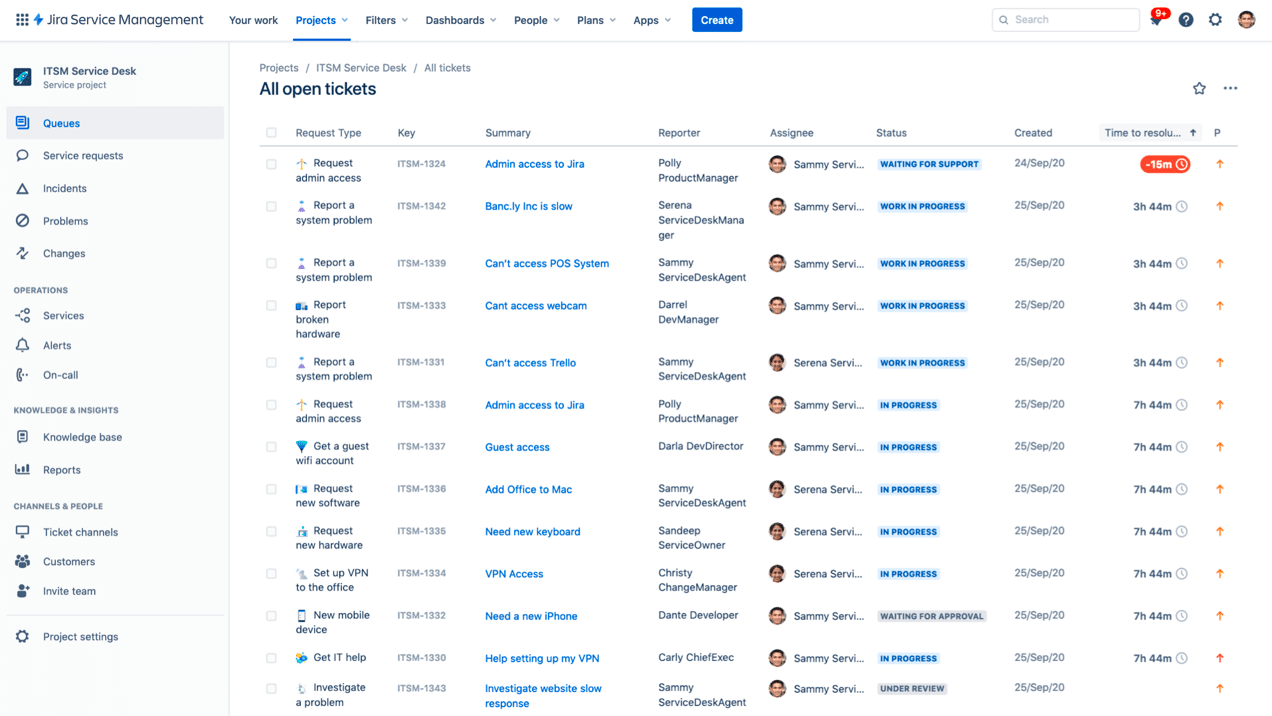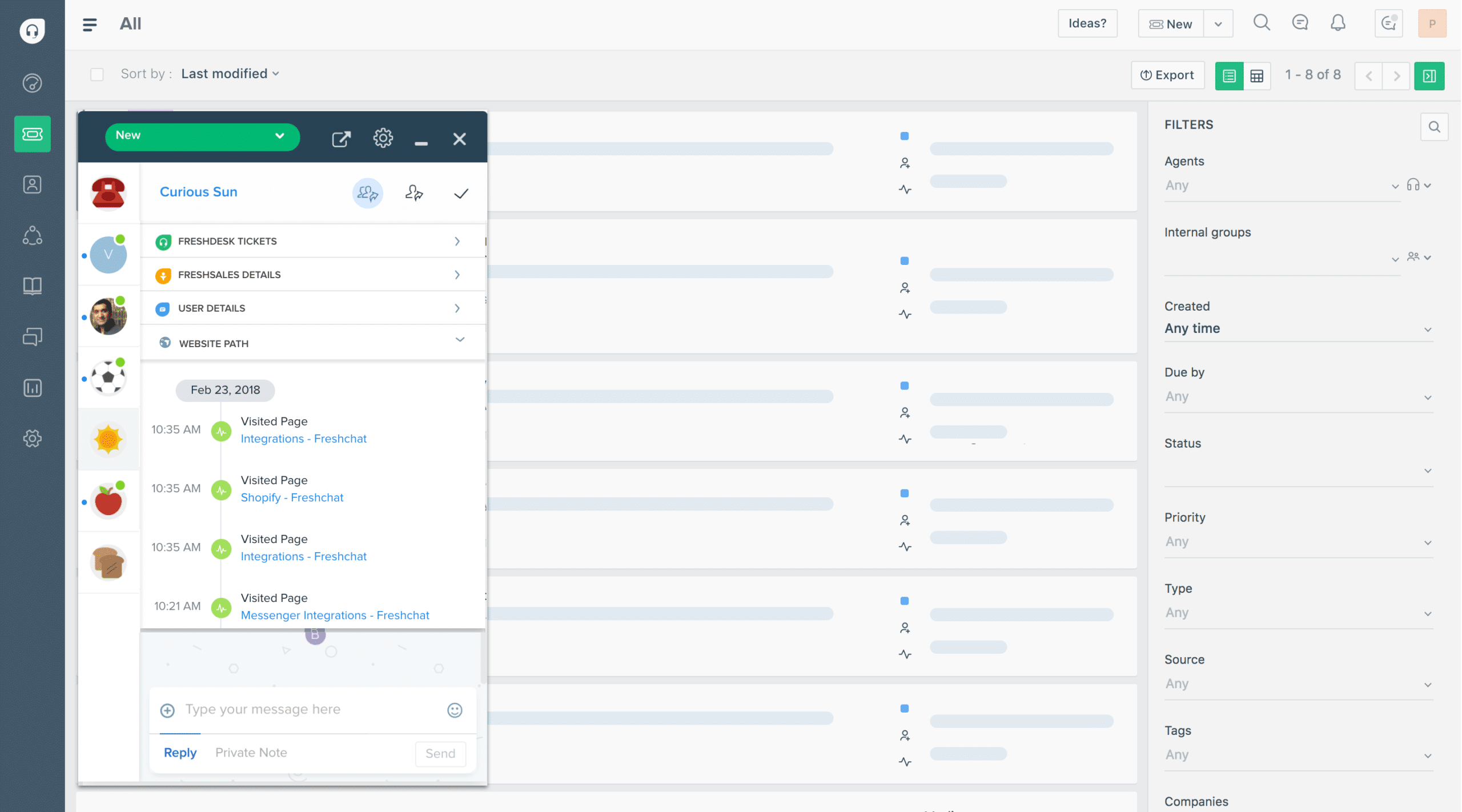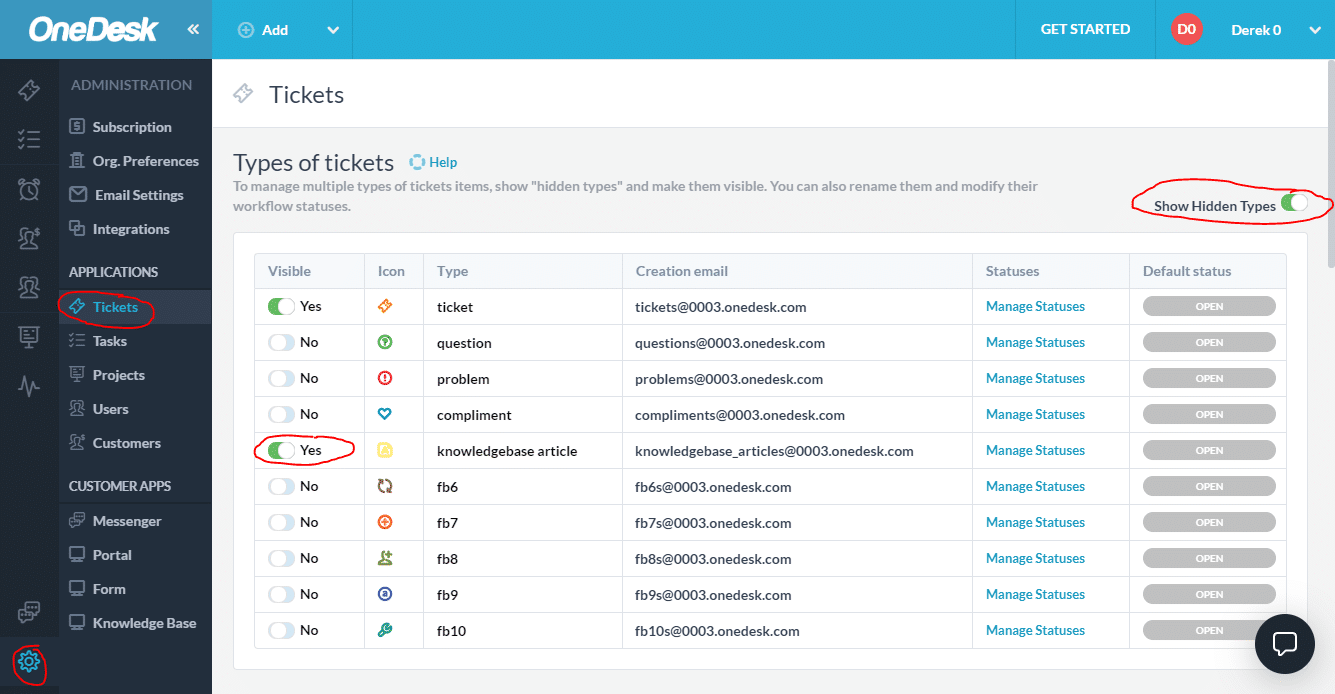The number of digital devices, services, and apps has exploded in the previous two decades, transforming company operations across all industries. Simultaneously, the underlying IT infrastructure supporting this digital expansion has grown in complexity. In this growing complexity, most firms’ IT departments get a steady stream of warnings, notifications, and service requests or tickets from end-users.
Here is our list of the top service request management software:
- SuperOps PSA – EDITOR’S CHOICE This cloud-based system provides a ticketing system for Service Desk teams and can be paired with an RMM for IT asset management. Get a 14-day free trial.
- NinjaOne RMM – FREE TRIAL Cloud-based platform that enables MSPs to remotely manage client systems, including a ticketing system for service requests, automated problem notifications, and technician queue management. Start a 14-day free trial.
- ManageEngine ServiceDesk Plus – FREE TRIAL This package offers a straightforward Help Desk function or a plan that includes IT asset management as well. Available as a SaaS package or for installation on Windows Server or Linux. Download a 30-day free trial.
- Zendesk – FREE TRIAL This cloud-based system provides a Help Desk ticketing system that can track SLA compliance and can be linked up to a CRM package. Access the 14-day free trial.
- SolarWinds Web Help Desk Despite its Web-based delivery system, this tool is an on-premises software package that provides a ticketing system for support teams.
- HaloITSM Track task progress and team productivity with this ticketing system that includes a self-service portal for users. Offered as a SaaS package or for installation on Windows Server.
- Jira Service Management This product is an addition to the JIRA project and development management tool and can manage bug reporting and resolution in DevOps environments.
- Freshdesk This cloud-based system offers social media channels as well as email, phone, and chat for ticket creation and user communication.
- OneDesk This scaleable ticket management system is priced per technician and delivered from the cloud through any standard Web browser.
Prioritizing work in such a situation might be difficult for firms that lack the necessary tools for service request management. A service desk or IT ticketing management software can help in this situation. In this post, we’ll go over some of the most critical features to look for in service request management software, as well as a list of the finest service request management software currently available.
Main Features of a Service Request Management Software
As the name implies, service request management software assists IT teams in dealing with a wide range of customer or end-user demands. These can include requests for application access, a new or renewed software license, hardware installation, software configuration, password resets, and more.
The service request management software should aid the service desk personnel in managing requests throughout their entire lifecycle. It should also make it simple for end-users to submit a request, track its progress, and estimate the time it will take to resolve it.
In addition, the software should provide information on the efficiency and effectiveness of the complete service request management process. Decision-makers can gain a birds-eye perspective of their service desk teams’ performance with various performance reports, and assign resources to different departments or regions depending on workloads and business goals.
While service request management is critical, firms must also follow several other closely linked IT practices to ensure uninterrupted connectivity, productivity, and security, including:
- Incident management Managing unplanned events or contingencies that disrupt or degrade routine business/user activities
- Problem management Managing processes that help in the resolution of underlying issues or problems to reduce the frequency of associated events or incidents
- Change management Managing all change requests (adding, modifying, or removing something) with proper authorization and compliance, and ensuring there aren’t inadvertent disruptions due to these changes
Advantages of a Service Request Management Software
Employee requests are met on time thanks to an efficient service request management process. This procedure benefits firms in a variety of ways. Consider the following advantages of using service request management software:
- Automation of Repetitive Tasks Password resets, customer care responses, device installation, software license renewals, and other repetitive tasks can all be automated with service request management software. Human input is reduced by automation. As a result, your company’s employees are no longer required to react to service inquiries. As a result, the technology saves time for the staff by automating repeated processes. Additionally, corporate staff will be able to focus on more complicated concerns.
- Data Storage at a Central Place Users can track and monitor all service requests from a single portal with the help of a centralized request management system. To put it another way, you don’t need to go to other places to verify and reply to service requests. All of the data and searches will be in one location.
- Proper Management of Request Fulfillment The request fulfillment process is likewise covered by a service request management system. The process of tracking how, when, and who will respond to a service request is known as for request fulfillment. The tool provides a framework for ensuring that each service request is filed on time and in a consistent manner. It is a repeatable and consistent process from the user’s perspective.
- Better Communication A crucial feature of the service request management application is the ability to communicate with users. The software keeps consumers informed about the status of their requests and the time it will take to complete them. As a result, promptly responding to a customer care request establishes confidence and trustworthiness.
- Fact-Based Decisions You can keep track of customer requests and analyze performance with Service Request Management software. Recently, the company has been able to use this data in conjunction with factual data to conclude. The tool also assists in identifying areas that require improvement, time, and attention.
- Labor Cost Reduction There are numerous benefits to implementing service request management software, including cost savings. Because the automated program will handle the majority of the work, you can eliminate the need for additional employees. It is not less expensive to hire an IT specialist for your company. You will also generate more profit and boost efficiency when your employees have more time to focus on other areas.
- Instant Feedback When a customer submits a service request, a complaint, or a question, you learn more about the flaws and areas that need to be addressed. Constant connection with consumers can help you fill in the gaps and expand your company in the long run.
The Best Service Request Management Software
To deliver the greatest service to clients, several frameworks are used. Rather than relying on IT personnel to handle support requests, it is preferable to locate software that collects and manages all client demands. Your IT team members will be able to focus on other operations and perform important work as a result of this.
To help you out, we’ve compiled a list of the best Service Request Management Software that has been on the market for a long time and has consistently given excellent results. No corporation wants to irritate its customers by providing late responses and services. Check out the top request management software and its perks below to make your process go more smoothly and quickly:
Our methodology for selecting service request management software
We reviewed the market for service request management systems and tested the tools based on the following criteria:
- A web-based console that can be accessed from anywhere by a geographically-spread team
- An interface to enable users to input service requests
- Feeds from system monitoring tools that convert alerts into service request tickets
- An automated ticket routing system that can be set up according to technician capabilities
- Options to manually reassign, merge, or split tickets
- A free trial or demo to enable an assessment before paying
- Value for money from a package that has an appropriate price with respect to the services on offer
1. SuperOps PSA – FREE TRIAL
SuperOps PSA is a SaaS package that is available on a cloud platform that also offers a remote monitoring and management (RMM) system. This professional services automation system provides ticketing, task management, and team productivity tracking.
Key Features:
- A Service Desk system
- Designed for managed service providers
- Help Desk ticketing
- Time goals
- Technician to-do lists
Why do we recommend it?
SuperOps PSA is a package of professional services automation tools for use by managed service providers. The full bundle includes contracts management, automated timesheets, and billing systems but the core utility is the ticketing system. The cloud-based system provides consoles for managers and technicians with automated ticket routing.
Users can raise a service request through a Help Desk portal or by email. The tool will immediately send an automated response, detailing the ticket number and some text of your choosing. Those service request messages are then processed by the ticket management system. You can set up routing to automatically queue and deliver tasks to specific technicians or to a pool for allocation to the next available team member.
Communications between the technician and the user are interpreted into a chat interface in the technician console. The support operative doesn’t need to know the user’s email but just types in a message and the SuperOps system repackages it into a mail and sends it.
Team managers can track progress in requests and reroute them when necessary for escalation. All team member contributions to each request are logged and automatically compiled into timesheets and invoices.
Who is it recommended for?
This system is designed for use by managed service providers. The PSA package provides company management tools, which include task goal tracking and employee productivity monitoring. It is also possible to get a combined PSA and RMM package that includes tools for use by technicians. The package is priced per technician.
Pros:
- Manages 150 endpoints per technician
- A cloud-based system with Web interfaces for role-linked dashboards
- Automated ticket routing and task queuing
- Links task completion times to SLA requirements
- Integrated CRM to manage client accounts
Cons:
- Works best in conjunction with the SuperOps RMM package
You can assess the SuperOps PSA system with a 14-day free trial.
EDITOR'S CHOICE
SuperOps is our top pick for service request management software because it combines powerful features, intuitive design, and advanced automation. These tools are all tailored to enhance IT service efficiency. Designed for managed service providers (MSPs) and IT teams, SuperOps integrates seamlessly with workflows, enabling effective handling of service requests, asset management, and ticket resolution. An important component of SuperOps is its automation capabilities. The platform allows users to create event-based triggers and runbooks, automating routine processes like ticket assignments, prioritization, and escalations. This reduces manual effort, ensuring teams can focus on high-value tasks. Its visual ticketing system, including Kanban-style views, simplifies task organization and provides a clear overview of pending, in-progress, and completed work. SuperOps has a modular design, which allows businesses to adapt the platform to their unique operational needs. Users can set up service-level agreements (SLAs), manage client communications, and monitor performance metrics. These functions are all collected in a single interface. Its integration capabilities with tools like QuickBooks and Splashtop enhance functionality, streamlining financial management and remote access. Another significant advantage is its focus on collaboration and context. Teams can access a centralized workspace for internal notes, client communication, and project tracking. This ensures that all stakeholders remain informed and tasks move forward efficiently.
Download: Get a 14-day FREE Trial
Official Site: https://superops.com/signup
OS: Cloud based
2. NinjaOne RMM – FREE TRIAL
NinjaOne RMM is a cloud platform of systems that enable managed service providers (MSPs) to look after the systems of their clients – a package that is known as remote monitoring and management (RMM). That remit includes the support of users, which is implemented through a service request ticketing system.
Key Features:
- Includes a ticketing system
- Tools for technicians
- User self-service portal
Why do we recommend it?
NinjaOne RMM is a remote monitoring and management package that supplies tools for technicians for use in their work supporting IT systems. RMM packages don’t usually include a ticketing system – traditionally that is part of a PSA package. So, this system is ideal for companies that already have their business management software in place and don’t need all of the units of a professional services automation (PSA) package, just the ticketing system.
The ticketing system processes service requests from the user community and automated problem notifications from system monitors. The tool can prioritize those tickets either according to source or regardless of origin. The service can be set up with a ruleset to automatically route tickets to individual technicians for consideration.
The technicians each have a queue of tickets to work on, which appears in a console that is protected with access controls. The technician can choose to switch between tickets and make notes on each docket. This is necessary if a ticket is on hold awaiting further information.
The users raise tickets through a self-service portal, which can be branded with the identities of the client or the MSP. This portal includes a communication channel, like an email inbox, in which the system can post automated progress notifications and the technician can request further information or present a solution.
The team manager gets feedback on ticket progress, It is possible to reroute tickets manually in the chase when a ticket is not accessed quickly because the technician is too busy. Technicians can also forward tickets for consideration by specialists.
Who is it recommended for?
The lack of PSA utilities in the NinjaOne package means that its audience isn’t limited to managed service providers. This system will also appeal to in-house IT departments that support their own company’s users. NinjaOne doesn’t publish its price list, so it is difficult to judge whether the package will appeal to price-sensitive small businesses.
Pros:
- This is a cloud-based system so your technicians don’t all have to be in the same room to access the system
- Routing algorithms can be customized
- Automated timesheet compilation for billing
Cons:
- No price list
The NinjaOne RMM provides monitoring and system management tools in addition to the ticketing service. Other features of the package include autodiscovery, hardware and software inventories, and patch management. You can examine the NinjaOne system with a 14-day free trial.
3. ManageEngine ServiceDesk Plus – FREE TRIAL
ManageEngine ServiceDesk Plus is a cost-effective, adaptable, and scalable platform that includes help desk and IT asset management features. The software may handle asset tracking, ticket administration, and any other service.
Key Features:
- On premises or cloud-based
- Incident, problem, and change management
- Self-service portal
Why do we recommend it?
This package is a rival to the HaloITSM system because it is a full Service Desk system. You get a service request management utility with this large package and this includes a self-service portal. The user interface has a knowledge base to help filter out routine problems, such as password reset requests, and lighten the workload of user support staff.
Who is it recommended for?
This is a very large package, but its entry-level edition, called Standard, is priced to be accessible to small businesses. The two higher editions suit mid-sized and large organizations. ManageEngine offers this system as a cloud-hosted SaaS package but you can choose to download the software and run it on Windows Server or Linux.
Pros:
- Robust all-in-one tool for managing client contracts, maintenance requests, and other ancillary services MSPs normally offer
- Automatic asset discovery helps keep NOC teams informed of scope and new devices that are added to the network
- Cross-platform support works with Windows or Linux server distros
- Available for on-premise deployment as well as a SaaS
Cons:
- ManageEngine offers a range of services and products that can take time to fully explore and utilize
ServiceDesk Plus is one of the best solutions on the market because of its top-of-the-line features. Standard, Professional, and Enterprise are the three editions of the tool. Customers can also use the software’s knowledge base template to try to solve problems on their own and contact experts via other channels if they need assistance. ManageEngine ServiceDesk Plus works on any device and in any language. It also has auto-discovery and sophisticated reporting capabilities for analyzing performance.
Get started by downloading the 30-day free trial.
4. Zendesk – FREE TRIAL
Zendesk is a cloud-based help desk software that uses a ticketing system to track down and resolve issues. It has chat alternatives for communicating with consumers as well as a knowledge base where users can look for answers to their questions. It’s a self-service site that also includes a debate and solution forum.
Key Features:
- Cloud based
- Four plan levels
- Chatbot
Why do we recommend it?
Zendesk offers two versions of its Help Desk system: one for service support and the other for sales. The Zendesk for Service package includes a self-service portal template with a knowledge base section that can be set up. The deal also includes a chat interface with a bot to filter out routine problems.
The nice thing about Zendesk is that it is suitable for various types of businesses. Additionally, the tool has time-saving widgets for sharing and automation, as well as SLA compliance, customizable ticket forms, and more. It is one of the easiest tools to set up and use for service request management.
Who is it recommended for?
Zendesk is a widely used package and it is particularly popular with online systems for customer support. The customer list of the tool includes some very large businesses, including Siemens, the UK’s National Health Service, Skyscanner, Banco Sabadell, and KFC. The service is also used by websites and VPN systems for customer support.
Pros:
- Simple and intuitive interface
- Centralized ticketing management and chat helps consolidate team-based tools
- The knowledgebase is easy to setup and helps reduce new tickets
Cons:
- Pricing is based on the number of agents deployed
- Volume of settings and options can be overwhelming for smaller helpdesks
- Permission settings are too broad
Zendesk’s strong analytical and reporting capability also aids in the detection of system faults. The success of a company is determined by the relationship it builds with its customers. Look no further if you’re seeking a tool that offers dependable customer service and powerful automation capabilities. Zendesk has a live chat feature and works nicely with third-party apps. Register for the free demo and gain access to the 14-day free trial.
5. SolarWinds Web Help Desk
SolarWinds Web Help Desk is a popular IT ticketing management software that automates ticket routing and helps ITSM teams analyze faults quickly. It also works in tandem with knowledge base articles to make managing service requests, known issues, and service level agreements a breeze.
Key Features:
- Self hosted
- Web console for technicians
- SLA goal tracking
- Active Directory integration
- User self-service portal
Why do we recommend it?
The SolarWinds Web Help Desk system provides a Web system from self-hosted software. This is a nice combination for companies that don’t trust cloud-based systems because they get the full advantage of Web usability without loss of control. The package presents a range of interfaces, including a user portal, a management dashboard, and technician screens.
While the list of functions is extensive, the native integration with LDAP and Active Directory is a major feature that helps businesses with the initial setup. The program enables the dynamic construction of custom request forms with infinite fields to aid in the collection of crucial data and information for ticket resolution. Business-based action rules are also available in the Web Help Desk to automate ticket assignments and changes.
Web Help Desk’s rule-based approval and voting tools help firms track and automate their procedures for successful change management. It assists in dynamically selecting approvers and changing advisory boards based on the request’s origin. Managers can also use a built-in configurable reporting dashboard to track the performance of service desk teams in real-time.
Who is it recommended for?
This is a good choice for any business that runs a Help Desk for users or customers. The package includes channels to get service requests into the system both through a self-service portal for users and through connections to system monitoring tools. The self-service portal includes knowledge base templates to enable users to fix their own problems instead of raising a ticket.
Pros:
- Simple layout makes management easy, even at scale
- On premise tool, a good option for organizations that do not want a cloud solution
- Can track time entries, as well as SLA performance for helpdesk teams
- Proactive alerts can notify staff when SLAs are in danger of being breached
Cons:
- Does not offer a cloud version
The dashboard shows the status of service requests, real-time billing information, key problem categories and their origin locations, and more. Visit the SolarWinds website to read more about the program, or start your evaluation with a fully functional 14-day free trial. SolarWinds Service Desk software is an on-premises solution, and enterprises looking for cloud deployment should look into it.
6. HaloITSM
HaloITSM is a cloud-based platform that analyses IT processes and aligns them with business goals for companies of various sizes (Sony Music, Network Homes, etc.). It is a well-known program that includes capabilities such as a configurable knowledge base, incident management, problem management, and configuration management, among others.
Key Features:
- ITIL based
- Incident management
- Asset tracking
Why do we recommend it?
HaloITSM is an asset management and service management package that includes a Help Desk ticketing system as part of its Incident Management unit. This unit starts with a self-service portal in which users can raise a service request. The package provides ticket routing for task allocation and completion goal tracking.
It helps operators to keep track of priority levels, ticket IDs, origination dates, and other details that help them complete tasks more quickly. The Service Request Management Software offers a user interface that can be customized and is remote control compatible.
In addition, HaloITSM is a self-service portal with a user-friendly dashboard and customer support available 24 hours a day, 7 days a week. You may also combine the tool with a variety of third-party programs, including Sage, Xero, and Twitter. With its sophisticated capabilities, HaloITSM has become a popular tool over time. The program can also be used to automate workflows, undertake analysis, and generate reports.
Who is it recommended for?
This package is a full ITSM package rather than just a service request management tool, so it is suitable for businesses that are looking for IT Service Desk department software to manage all of their functions, not just incident management. HaloITSM doesn’t publish a price list.
Pros:
- Great admin dashboard – easy to navigate and quickly learn
- Includes a technician toolkit
- Supports workflow automation – great for reliably servicing complex clients
- Can be installed locally or be used as a SaaS
Cons:
- Must contact for pricing
You can also start from scratch and include charts and numerical data to make your reports more visually appealing. The best Request Management Software includes a variety of channels so that customers may connect and interact with the company more easily. Get a 30-day free trial.
7. Jira Service Management
JIRA Service Management strives to create a positive client experience. It’s JIRA-based software with a simple user interface and a lot of flexibility. Several elements of the software stand out, including automatic request management, real-time reporting, and SLA support.
Key Features:
- IT operations support
- Support customers or in-house users
- Integrates with Slack
Why do we recommend it?
The producer of Jira Service Management, Atlassian, is well-known for their development project management system, called Jira. This tool can integrate with the project management system to report problems with new services that require rework. Another innovative integration of the Service Management tool is that it allows users to raise tickets through Slack.
The program has been on the market for a long time and is one of Atlassian’s greatest solutions. It allows users to create customized customer portals where clients can quickly fill in the gaps with their demands and submit service requests. Before submitting, end-users have the option of exploring the self-service knowledge base to find a solution on their own.
Who is it recommended for?
This package competes with the ManageEngine and HaloITSM tools on this list because it is a full system management package rather than just a Help Desk ticketing system. Although Jira is considered a very high status provider, the company offers a Free tier for the Jira Service Management package, which will delight small businesses with up to three technicians.
Pros:
- Provides an easy platform to integrate other Jira solutions
- Leverages artificial intelligence and machine learning to improve alerts and escalations
- Includes over 550 marketplace apps
- Widely supported – large community
- Excellent knowledgebase features
Cons:
- Could use a longer trial to test all features
Users may easily discover relevant information to their questions on the site, or they can contact the company directly via phone, email, or chat. You may also use real-time analytics to see how the service desk is working and report on areas that need to be improved. Furthermore, the continuous repetition of tasks lessens the stress on staff employees. You won’t require an agent to do each task; instead, the program will take care of everything and provide speedier outcomes. Finally, you may connect JIRA Service Desk to other Atlassian and third-party applications.
8. Freshdesk
Freshworks launched Freshdesk, which quickly became one of the most popular help desk software solutions. You do not need to download any additional software because it is simply accessible online. To engage with customers immediately, the strong tool offers numerous channels such as email, phone, Twitter, and Facebook. It also offers a knowledge base, forums, and other venues for customers to share information and find solutions on their own. If you don’t want to assign human agents, several automated bots can play a vital part in answering user queries.
Key Features:
- A Help Desk module
- A Service Management module
- Self-service portal
Why do we recommend it?
Freshdesk is one of the tools available from Freshworks. The company also produces a Chat utility for communicating with visitors to a website, a package of both those tools, called Customer Service Suite, a service management module, called Freshservice, and a sales CRM tool, called Freshsales. The Freshdesk unit is available individually and includes a Help Desk ticketing system.
Who is it recommended for?
This is a useful package for all sizes of business. The Freshdesk system is geared towards supporting customers and the Freshservice package is for Service Desk teams, supporting in-house users. While the Freshdesk unit has a free tier that provides Help Desk management tools for up to 10 technicians, there isn’t a free edition for the Freshservice module.
Pros:
- One of the better user interfaces for ITSM tools
- Includes a self-service portal to help reduce inbound tickets
- Simple ticket creation is user-friendly for new staff
Cons:
- The trial could be a bit longer
Look no further if you’re seeking high-quality Service Request Management Software. FreshDesk provides excellent freemium plans as well as free sessions to test out essential features. It aids in the automation and monitoring of IT workflows. Furthermore, the tool has a simple configuration that makes it simple for clients to register and submit requests. The agents can promptly resolve and label tickets. SLA tracking, reporting, SSL certificates, automated ticket routing, DKIM setting, and more capabilities are available in FreshDesk.
9. OneDesk
OneDesk is a popular service request management software that allows you to gather and manage customer requests, track status, keep track of assignees, and more. It’s adaptable, has a structured interface, and provides insight into the current condition of affairs. For various responsibilities, the majority of firms and sectors prefer to use OneDesk. OneDesk also aids in the transformation of the request management process into a simple routine.
Key Features:
- Help Desk ticketing
- Ticket routing
- Time tracking
Why do we recommend it?
OneDesk is a cloud-based service desk package with three plan levels. All of the plans provide a Help Desk ticketing system and even the lowest edition includes project management tools for tracking development projects. The second plan includes business management tools, such as contracts management and billing.
Users can also add custom fields and characteristics to the software as needed and convenient. There is a lot of important information that can make the process go more smoothly. By having details related to the priority, creation date, summary, and status one can respond faster to the clients.
A Tickets application is included in the software, which aids in the tracking of service requests and the establishment of workflow. After you’ve defined the workflow, you can start automating it. E-mail integration is also possible with this powerful tool. As a result, if a customer submits a service request via email, the request is collected automatically in the OneDesk system.
Who is it recommended for?
The three plan levels of the OneDesk system make it suitable for all sizes and types of businesses. The basic plan, called Standard, is a Service Desk package for in-house IT departments supporting their own business’s users. Managed service providers could use that edition, but they are better catered for by the Premium edition, which includes professional services automation (PSA) modules.
Pros:
- Great interface – highly scalable and customizable
- Users can build simple or complex workflows for incoming tickets
- Supports automation
- Very easy to use
Cons:
- Better for small to medium size networks
On task completion, the tool also ensures that the client receives a notice summarizing the Service Request’s status. Another advantage of using OneDesk is that all of these chats may be seen and saved for later use. Most businesses prefer it to their competitors since it is simple to use and has a lot of features.
Service Request Management Software FAQs
What are some common features of service request management software?
Common features of service request management software include ticket tracking, automated routing and escalation, service level agreement (SLA) management, knowledge management, reporting and analytics, and customer self-service.
How can service request management software benefit an organization?
Service request management software can benefit an organization by improving service delivery and response times, reducing resolution times and downtime, increasing customer satisfaction and loyalty, and enabling better decision-making through data and analytics.
What types of service requests can be managed with service request management software?
Service request management software can manage a wide variety of service requests, including IT support, facilities maintenance, human resources, and customer service.
Can service request management software be customized to meet specific organizational needs?
Yes, service request management software can be customized to meet specific organizational needs, through the use of custom workflows, ticket fields, and forms.
Can service request management software integrate with other software and systems?
Yes, service request management software can integrate with other software and systems, such as customer relationship management (CRM) software, enterprise resource planning (ERP) software, and IT service management (ITSM) software.
